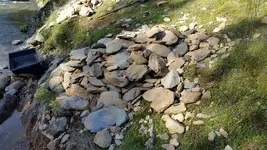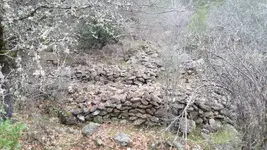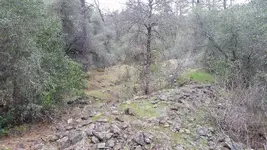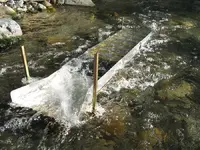Actually I've been building my own stream sluice boxes for years. I stopped using riffles, miners moss and gravel guards almost immediately. Throwing unclassified, unprocessed soil on a sluice is counterproductive. At first thought, that might seem like the best way to get the most gold. Just have three gorillas shoveling raw dirt onto a sluice box. LOL. Then you look at the time someone spends removing the sluice from the creek, removing all those gadgets, cleaning them, reinstalling them and resetting the sluice in the creek.. and here come the gorillas with more shovels of soil, and five minutes later it's time for another cleanout (while the gorillas stand around leaning on their shovels smoking cigarettes). Doesn't sound very efficient to me, and when you see it for yourself, it doesn't look very efficient either.
The trick is to properly classify and wash your soil BEFORE you throw it on the registry pad of your sluice (and I'm not just talking about shaking it through a screen, which doesn't remove clay, or mud). First you set up a wet five gallon bucket with a solution of my homemade "Clay-B-Gone". The biggest rocks from the digging that won't go on the screen are washed off in this mixture (because there might be some flour gold clinging to them). Wear a kitchen rubber glove, or you'll rub the skin off your hands cleaning the rocks.
The wet bucket solution is two gallons of water, a couple squirts of fluoride tooth paste (that gives you a free ion of fluoride) and some hydrogen peroxide (that gives you a free ion of hydrogen). You can make this for about $2 dollars. This is what archeologists use to liquefy clay and mud. The mixture is perfect when it turns a pretty blue. The solution in the bucket can be reused a couple of times.
After you wash off the big rocks, you return to the dry bucket and place some dirt on a 1/4 inch screen held over it. Again.. with your gloved hand vigorously work the dirt through the screen down into the bucket. Once you have a pretty good amount of gravel and small rocks on the screen, take this material over to the wet bucket and wash it as well. Afterwards, just toss it if you don't see anything interesting in it (like something gold colored). Repeat the process until you have a substantial amount of classified dirt in the dry bucket. Carry it over to the wet bucket and pour it in while you stir the solution rapidly with a stick. Pour the solution into another bucket, careful not to pour any of your clean concentrate into the bucket. All that will now be left in your wet bucket is a little water, some small heavies, white sand, black sand and of course gold.
Step over to your stream sluice and gingerly sprinkle the clean concentrate onto the registry pad. I incorporate two, or three "Razor Hog" rubber gold mats in my sluice. Nothing else. No Hungarian riffles, no miners moss, no gravel guards. They aren't necessary. The Razor Hog mats will catch every piece of gold (even the finest flour gold). The white sand and black sand mostly just floats over them. I tested them, and retested them dozens of times. They are all you need in your sluice box if you've properly classified and washed your dirt. Don't believe me ? Test them yourself. You won't ever buy a Keen sluice, or any of that other junk off the internet again.[/QUOT
Stephan they are called Gold Hog , one of his matt types is "Razor Back" Doc built his sluice so that you don't have to classify.
Dawn in anything makes suds you don't want suds. A surfactant is better like Jet-Dry. Put dawn in a recirc and you will not be happy. Most guys using clay be gone are using it in the desert in recirc systems. Once your panning cons you don't really need it. there is no way to use it in an open system.
A fun prank the kids to to the fountains at the malls here is to add some concentrated dish soap to the water in the middle of the night by morning the foam blob is huge. Driving through one is fun the foam blows and floats everywhere.
Mytimetoshine may have seen them do it on El Dorado Hills Blvd. and White Rock Road. Seems to be a local favorite.
I will out " prospect" a poop tube with a gold pan.
When it's time to sluice it's time to sluice. I am not blowing out my gold.
Cleaning up more than once or twice day is counter productive. Unless your changing spots.
Claeaning out a sluice or two even with riffles is not a major task or time consuming. If it takes more than ten minutes something is wrong.
Sluice boxes were invented for situations that you have water. So, that less people could run more material in less time and get more gold.
A sluice is there to use the water to break up material, allow gold to settle out and move tailings away from you.
Three foot stream sluices do get finicky at low flow and riffles are problematic, for through put
The main advantage of classifying for a sluice is to concentrate the material and be able to use less water.
If you have the water and length you can shovel like a gorrilla and get great recovery.
You are right about riffles being a hang up though large heavies can move down a sluice so having a nugget trap is key.
The high majority of all gold put into a sluice box will settle out in the first foot. The head of a sluice is the slowest water.
Fast water carries the light material away once the gold settles it is hard to get it to move again.
My feed sluice is low profile, 1/8 thick expanded over moss and carpet. major research in the Yukon and field results prove that it is an excellent set up for fine gold recovery. Everything after that is for just in case.
I have to be able to catch anything from gram plus nuggets, quartz with gold attached and fines down to flea poops in the same system. And I do. Easily down to 200 mesh.
Based on your perception of how sluices work a suction dredge would never work. Granted because of water volume and material size once your over a 3" fine recovery needs some tweaking. Hence multi stage sluices.
A lot of guys are scared to run material. They blame their recovery on their gear. Nine times out of ten it's the dirt being ran. Coupled with the fact that they aren't running enough of it.
Because they are spending too much time over a classifier and bucket and not enough time feeding their sluice.







 The only crazier thing I can think of is a stream sluice constructed of balsa wood.
The only crazier thing I can think of is a stream sluice constructed of balsa wood.
